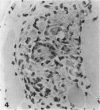Abstract
Frozen serial sections of muscle from 15 patients with polymyositis and three normal controls were studied by indirect immunofluorescence with a panel of mouse monoclonal antibodies to various human leucocyte components. The results showed good correlation with conventional histology. In addition, large numbers of T lymphocytes were identified in those cases with a marked inflammatory infiltrate. Many of the T cells probably bear HLA-DR antigen as the anti-HLA-DR antibody stained as many cells as the anti-leucocyte antiserum. This strongly suggests that the T cells present are 'activated'. In two patients HLA-DR-positive material was identified apparently diffusing from the infiltrates into muscle fibres suggesting its release as a soluble factor. In one case, structures with the appearance of giant cells were seen. The method promises to provide new information on the nature of infiltrating leucocytes which may provide more accurate diagnostic and prognostic information than conventional histology alone.
Full text
PDF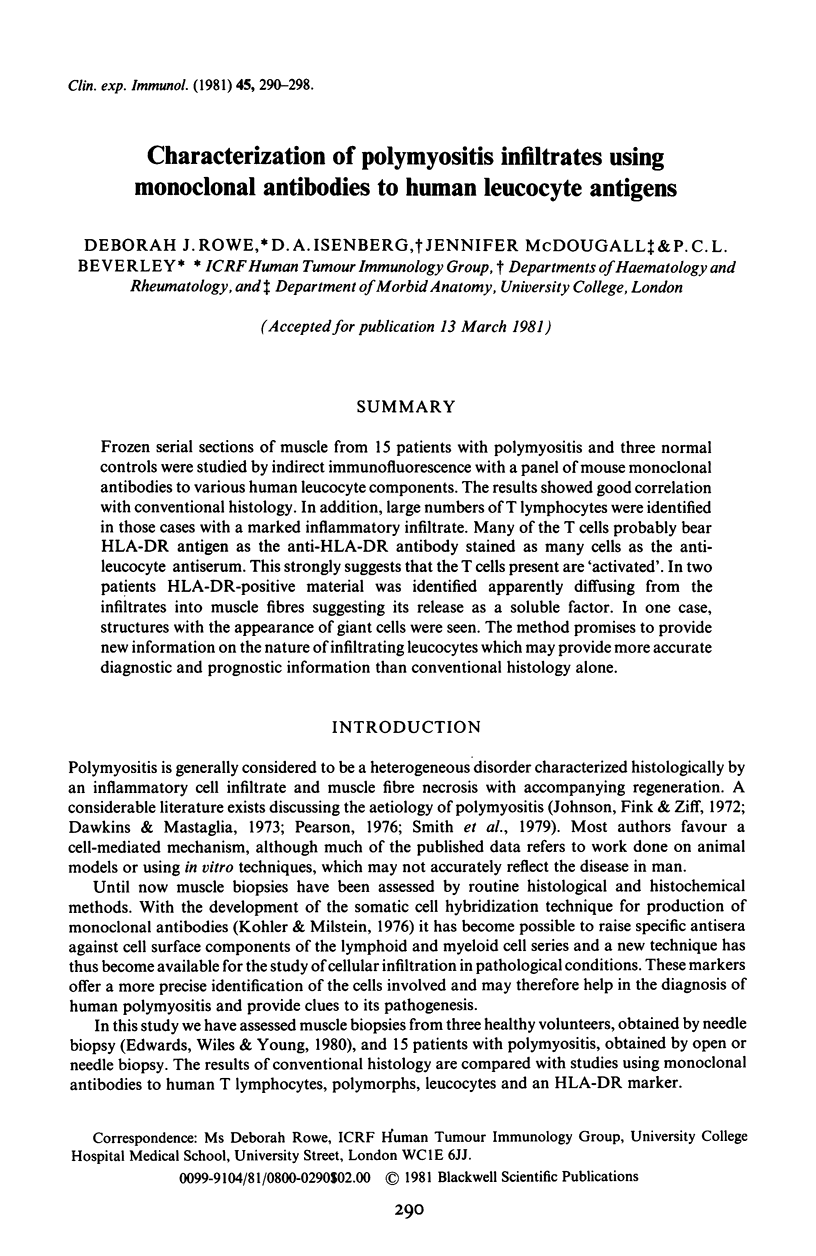

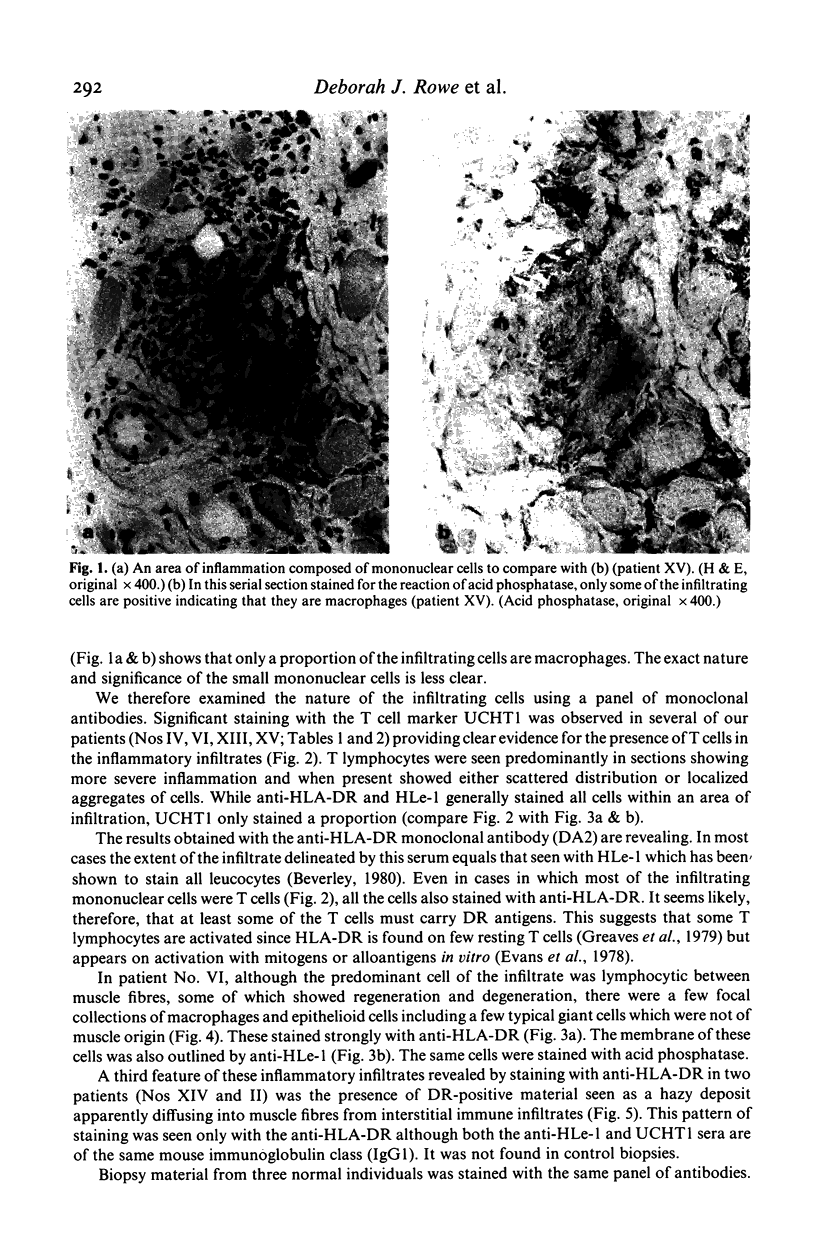



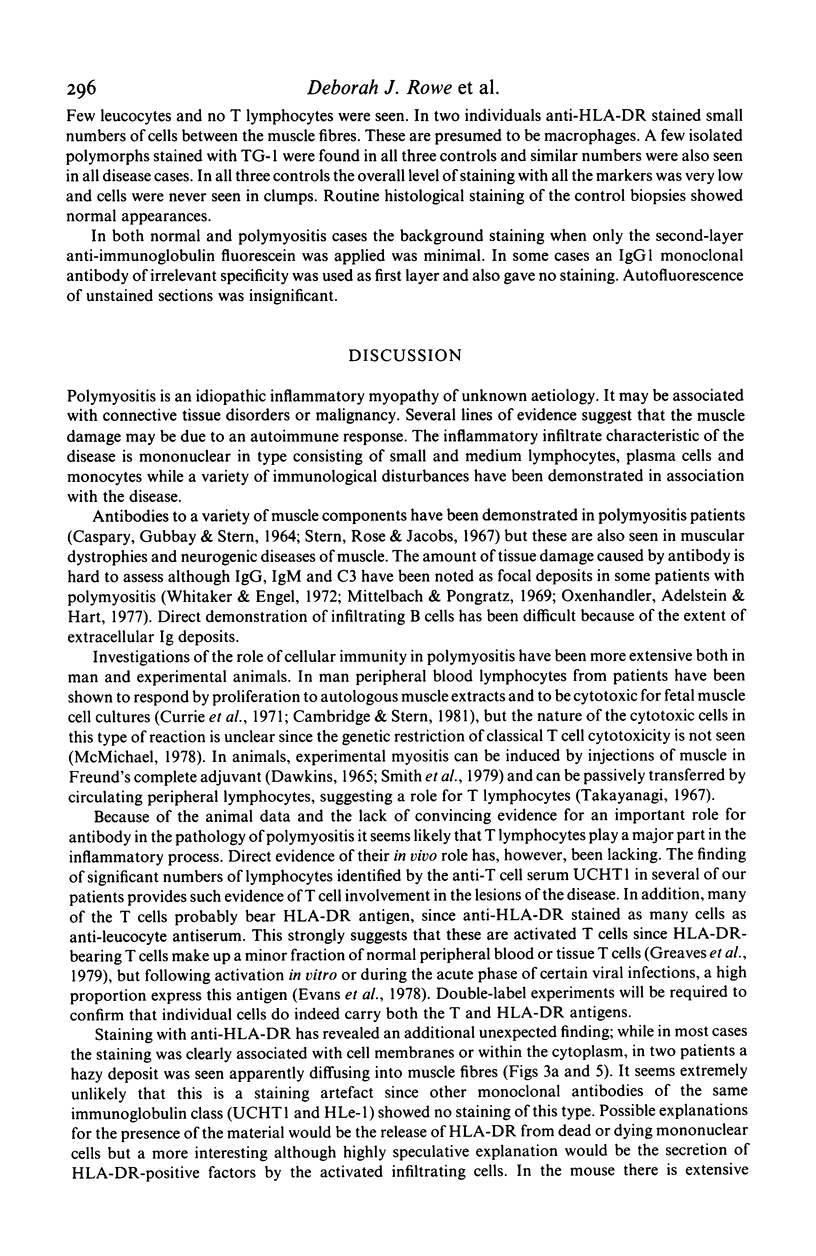

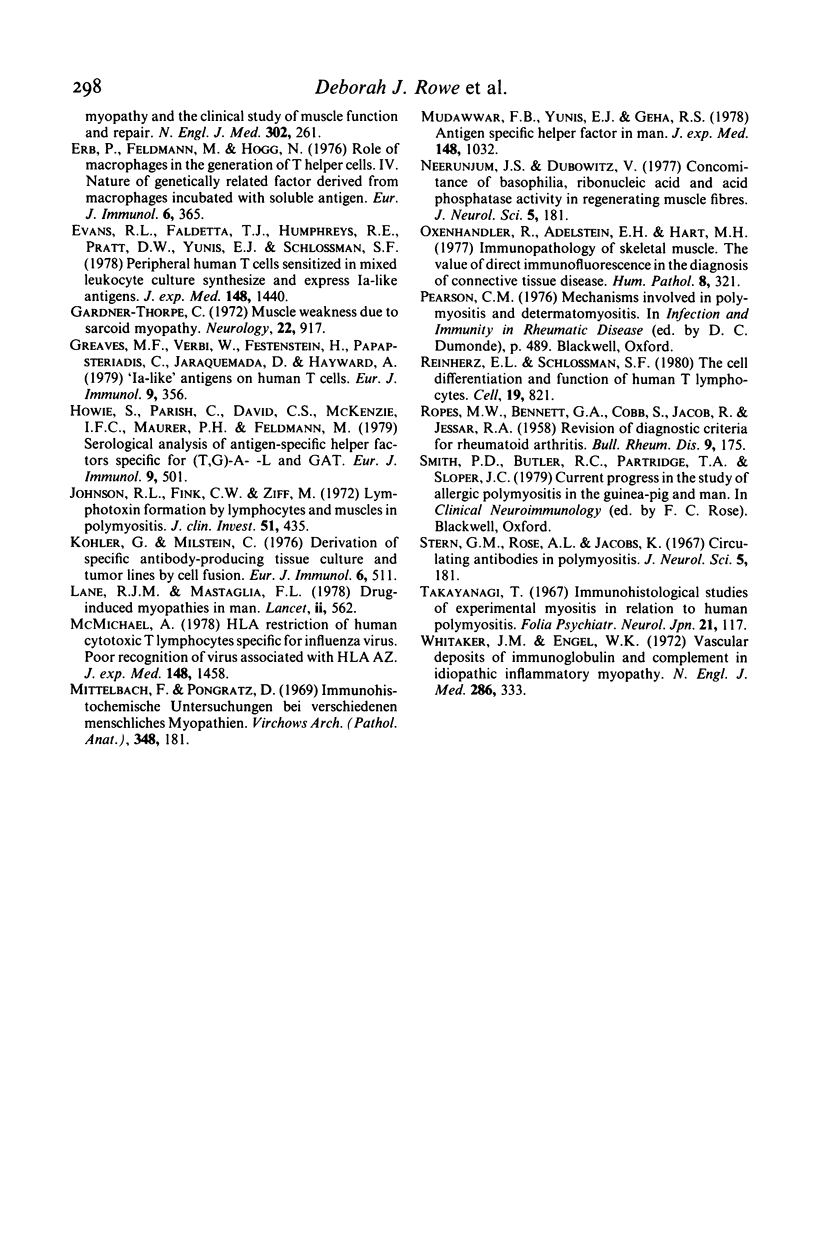
Images in this article
Selected References
These references are in PubMed. This may not be the complete list of references from this article.
- Beverley P. C., Linch D., Delia D. Isolation of human haematopoietic progenitor cells using monoclonal antibodies. Nature. 1980 Sep 25;287(5780):332–333. doi: 10.1038/287332a0. [DOI] [PubMed] [Google Scholar]
- Bohan A., Peter J. B. Polymyositis and dermatomyositis (first of two parts). N Engl J Med. 1975 Feb 13;292(7):344–347. doi: 10.1056/NEJM197502132920706. [DOI] [PubMed] [Google Scholar]
- Breard J., Reinherz E. L., Kung P. C., Goldstein G., Schlossman S. F. A monoclonal antibody reactive with human peripheral blood monocytes. J Immunol. 1980 Apr;124(4):1943–1948. [PubMed] [Google Scholar]
- Brodsky F. M., Parham P., Barnstable C. J., Crumpton M. J., Bodmer W. F. Monoclonal antibodies for analysis of the HLA system. Immunol Rev. 1979;47:3–61. doi: 10.1111/j.1600-065x.1979.tb00288.x. [DOI] [PubMed] [Google Scholar]
- Brooks D. A., Beckman I., Bradley J., McNamara P. J., Thomas M. E., Zola H. Human lymphocyte markers defined by antibodies derived from somatic cell hybrids. I. A hybridoma secreting antibody against a marker specific for human B lymphocytes. Clin Exp Immunol. 1980 Feb;39(2):477–485. [PMC free article] [PubMed] [Google Scholar]
- CASPARY E. A., GUBBAY S. S., STERN G. M. CIRCULATING ANTIBODIES IN POLYMYOSITIS AND OTHER MUSCLE-WASTING DISORDERS. Lancet. 1964 Oct 31;2(7366):941–941. doi: 10.1016/s0140-6736(64)90868-2. [DOI] [PubMed] [Google Scholar]
- Cambridge G., Stern C. M. The uptake of tritium-labelled carnitine by monolayer cultures of human fetal muscle and its potential as a label in cytotoxicity studies. Clin Exp Immunol. 1981 Apr;44(1):211–219. [PMC free article] [PubMed] [Google Scholar]
- Dawkins R. L. Experimental myositis associated with hypersensitivity to muscle. J Pathol Bacteriol. 1965 Oct;90(2):619–625. doi: 10.1002/path.1700900231. [DOI] [PubMed] [Google Scholar]
- Dawkins R. L., Mastaglia F. L. Cell-mediated cytotoxicity to muscle in polymyositis. Effect of immunosuppression. N Engl J Med. 1973 Mar 1;288(9):434–438. doi: 10.1056/NEJM197303012880903. [DOI] [PubMed] [Google Scholar]
- Edwards R., Young A., Wiles M. Needle biopsy of skeletal muscle in the diagnosis of myopathy and the clinical study of muscle function and repair. N Engl J Med. 1980 Jan 31;302(5):261–271. doi: 10.1056/NEJM198001313020504. [DOI] [PubMed] [Google Scholar]
- Erb P., Feldmann M., Hogg N. Role of macrophages in the generation of T helper cells. IV. Nature of genetically related factor derived from macrophages incubated with soluble antigens. Eur J Immunol. 1976 May;6(5):365–372. doi: 10.1002/eji.1830060512. [DOI] [PubMed] [Google Scholar]
- Evans R. L., Faldetta T. J., Humphreys R. E., Pratt D. M., Yunis E. J., Schlossman S. F. Peripheral human T cells sensitized in mixed leukocyte culture synthesize and express Ia-like antigens. J Exp Med. 1978 Nov 1;148(5):1440–1445. doi: 10.1084/jem.148.5.1440. [DOI] [PMC free article] [PubMed] [Google Scholar]
- Gardner-Thorpe C. Muscle weakness due to sarcoid myopathy. Six case reports and an evalation of steroid therapy. Neurology. 1972 Sep;22(9):917–928. doi: 10.1212/wnl.22.9.917. [DOI] [PubMed] [Google Scholar]
- Greaves M. F., Verbi W., Festenstein H., Papasteriadis C., Jaraquemada D., Hayward A. "Ia-like" antigens on human T cells. Eur J Immunol. 1979 May;9(5):356–362. doi: 10.1002/eji.1830090504. [DOI] [PubMed] [Google Scholar]
- Howie S., Parish C. R., David C. S., McKenzie I. F., Maurer P. H., Feldmann M. Serological analysis of antigen-specific helper factors specific for poly-L(Tyr, Glu)-poly-DLAla--poly-LLys [(T, G)-A--L] and L Glu60-LAla30-LTyr10 (GAT). Eur J Immunol. 1979 Jul;9(7):501–506. doi: 10.1002/eji.1830090703. [DOI] [PubMed] [Google Scholar]
- Köhler G., Milstein C. Derivation of specific antibody-producing tissue culture and tumor lines by cell fusion. Eur J Immunol. 1976 Jul;6(7):511–519. doi: 10.1002/eji.1830060713. [DOI] [PubMed] [Google Scholar]
- Lane R. J., Mastaglia F. L. Drug-induced myopathies in man. Lancet. 1978 Sep 9;2(8089):562–566. doi: 10.1016/s0140-6736(78)92894-5. [DOI] [PubMed] [Google Scholar]
- McMichael A. HLA restriction of human cytotoxic T lymphocytes specific for influenza virus. Poor recognition of virus associated with HLA A2. J Exp Med. 1978 Dec 1;148(6):1458–1467. doi: 10.1084/jem.148.6.1458. [DOI] [PMC free article] [PubMed] [Google Scholar]
- Mittelbach F., Pongratz D. Immunhistochemische Untersuchungen bei verschiedenen menschlichen Myopathien. Virchows Arch A Pathol Pathol Anat. 1969;348(2):181–186. [PubMed] [Google Scholar]
- Mudawwar F. B., Yunis E. J., Geha R. S. Antigen-specific helper factor in man. J Exp Med. 1978 Oct 1;148(4):1032–1043. doi: 10.1084/jem.148.4.1032. [DOI] [PMC free article] [PubMed] [Google Scholar]
- Oxenhandler R., Adelstein E. H., Hart M. N. Immunopathology of skeletal muscle. The value of direct immunofluorescence in the diagnosis of connective tissue disease. Hum Pathol. 1977 May;8(3):321–328. doi: 10.1016/s0046-8177(77)80029-4. [DOI] [PubMed] [Google Scholar]
- ROPES M. W., BENNETT G. A., COBB S., JACOX R., JESSAR R. A. 1958 Revision of diagnostic criteria for rheumatoid arthritis. Bull Rheum Dis. 1958 Dec;9(4):175–176. [PubMed] [Google Scholar]
- Reinherz E. L., Schlossman S. F. The differentiation and function of human T lymphocytes. Cell. 1980 Apr;19(4):821–827. doi: 10.1016/0092-8674(80)90072-0. [DOI] [PubMed] [Google Scholar]
- Stern G. M., Rose A. L., Jacobs K. Circulating antibodies in polymyositis. J Neurol Sci. 1967 Jul-Aug;5(1):181–183. doi: 10.1016/0022-510x(67)90015-9. [DOI] [PubMed] [Google Scholar]
- Whitaker J. N., Engel W. K. Vascular deposits of immunoglobulin and complement in idiopathic inflammatory myopathy. N Engl J Med. 1972 Feb 17;286(7):333–338. doi: 10.1056/NEJM197202172860701. [DOI] [PubMed] [Google Scholar]




